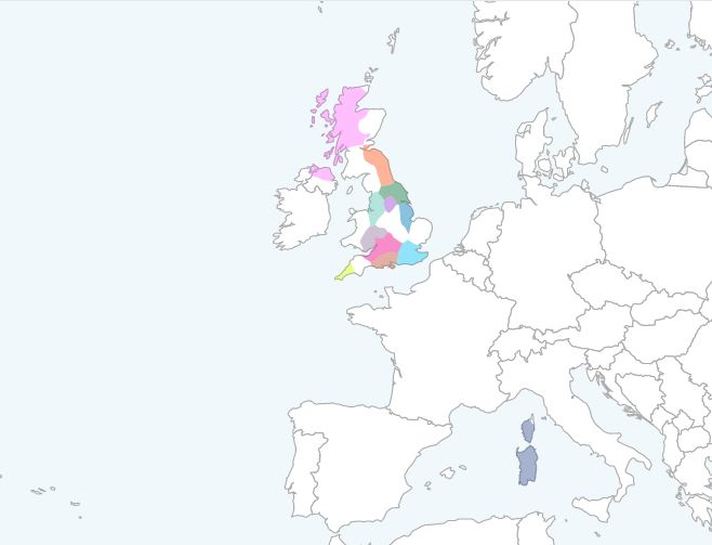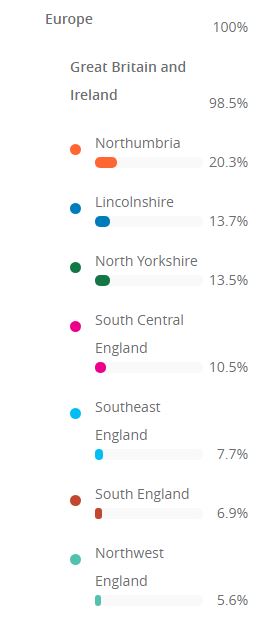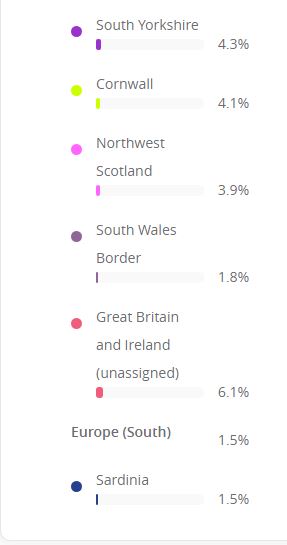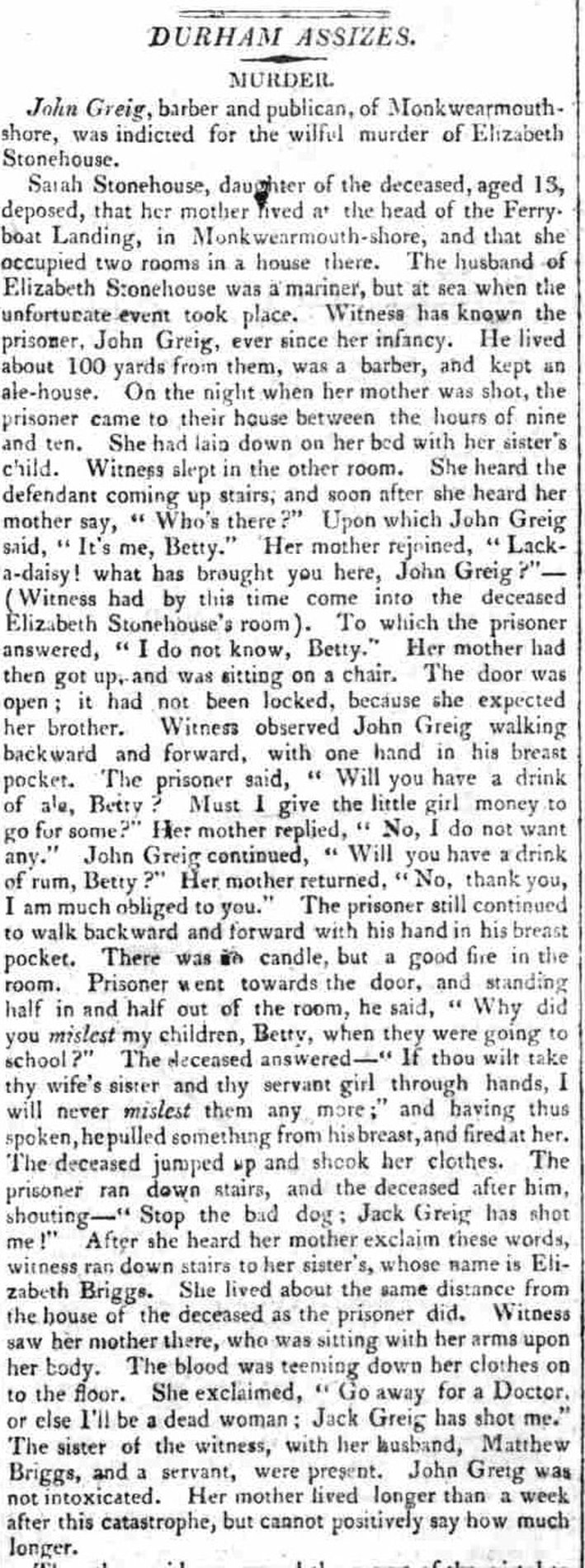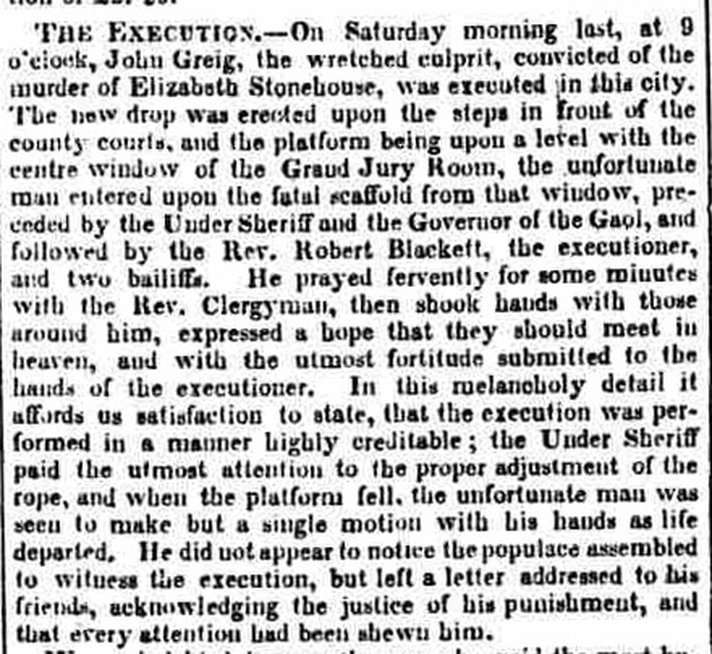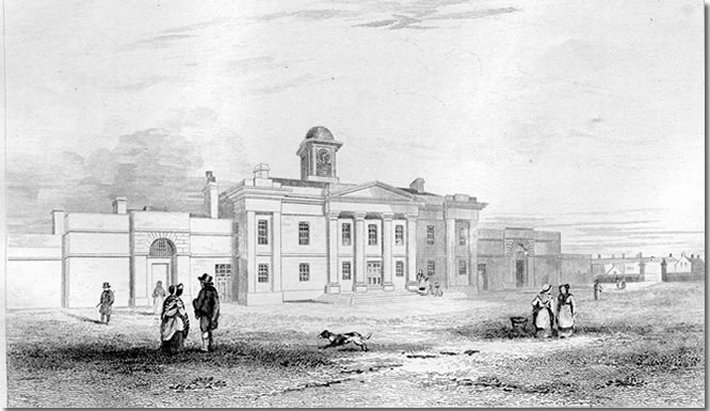|
I have received several tweets and emails from folks anxious to hear the results of my test with Living DNA. Well in the main I am going to keep you ‘hanging’ for a little longer! I shall give a brief overview and analysis of the results, but first I must congratulate the competition winners. Very well done to Sarah Rogers and Kim Strong who both correctly guessed the Northumbrian percentage of my own DNA as 20.3%. Many thanks also to David Nicholson of Living DNA for generously donating two tests as the competition resulted in a tie! The result was announced live at WDYTYA following the talk and presentation given by members of the Living DNA team to a packed audience in Theatre 3. I don’t think I remember much of the presentation (sorry guys!) as although as cool as a cucumber beforehand, the anticipation was just too much. The team had kept the results a secret as requested, (filed under the name Debbie Douglas, a nickname that affectionately seems to have stuck!), so this really was the first time I was going to have any insight into the secrets of my genes. By the time I got to the stage I really had turned into a bit of a sweaty palmed wreck, and was totally incapable of absorbing the information when it was finally revealed. Indeed it wasn’t until I had returned home and really looked at the results that they began to form patterns that correlated to the family tree created using traditional research methods. Northumbria tops the list at 20.3% but given the geographical definition for the purpose of the test, from Durham to north of the Forth in Fife, I initially expected this figure to have been higher. In fact, if I had been told this was my mother’s regional DNA profile I wouldn’t have given it a second thought. However this simply isn’t impossible as everyone inherits 50% of their genes from their father and 50% from their mother. To complicate matters there is no way of telling which genes we have inherited from our parents without testing ourselves. To help solve this mystery my mother’s DNA is now with Living DNA waiting to be analysed, and my brother will be testing very soon. Although he and I share the same parents, the 50% of DNA we have inherited from each parent will not be the same. Once these results are to hand I will be better placed to analyse the geographical spread of the DNA I have inherited, and from whom. I shall then write a full report detailing the ancestors believed to have contributed the most to my genetic geographical spread. Perhaps I shall also have an answer to where the 1.5% Sardinian has entered the equation, and confirmation that the as yet unassigned 6.1% presumed British is in fact Dutch. In the meantime, I have set about trying to work out the regional pattern I inherited from my father. A lot of previous research into his paternal heritage is pretty much in tablets of stone. His grandfather John Smith (d 1937) was 100% Northumbrian and Scottish Borders. Like many who focus on a particular relative or branch of their tree, this has become the basis of my ‘identity’ and how I see myself. However, this is a very misplaced notion as it disregards all the contributions to my genetic profile inherited from my other paternal ancestors. My great grandfather’s wife Mabel Herd was, for example, roughly 50% Lancashire, 25% Shropshire and 25% Angus and Fife! Yet, she is referred to by the family as being Scottish! There is no doubt that this notion of ‘Scottishness’ regardless how small the actual genetic percentage, is the driving force behind the success of Ancestral Tourism in Scotland. Unfortunately, this is to the detriment of other regions of the United Kingdom. I myself am just as guilty. Have I ever been to Shropshire – no, Lancashire – no, why? Because ‘granny Mabel came from Dundee’ of course! Actually that 25% was largely from Arbroath but let’s not split hairs – and so it goes on. Having thus reprimanded myself, and being driven by the overwhelming desire to now map together my ancestral genetic profile (yes, I am well and truly hooked), I set off to look at the part of my tree that is ‘sensitive’ to any self-respecting Geordie - the family that came from Sunderland. A ridiculous notion in itself and just another symptom of ahistorical assumptions that surround the question of ‘identity’. Taking the advice from a recent article ‘A plea to kill off our ancestors conclusively’ written by Rachel Bellerby of ‘Family Tree Magazine’ I proceeded to do just that. What better place to start than with the father of my 3x great grandmother Grace Greig born in Monkwearmouth Shore in 1809. Grace has cropped up before in several blogs, as she is the link between the rather colourful Dixon family and my Dutch ancestry. From Grace’s baptism and her parent’s marriage I knew them to be John Greig and Mary Bulmer. I had an approximate year of birth for John as 1780, and knew his occupation at the time of Grace's birth to be a barber and hairdresser. However, I had no record of when he had died. It was whilst searching for his probate record, which often holds significant clues to a persons life, that a link to a criminal record dated summer 1816 popped up instead! What happened next is best described by the opening lines from a Tale of Two Cities by Charles Dickens: It was the best of times, it was the worst of times, it was the age of wisdom, it was the age of foolishness, it was the epoch of belief, it was the epoch of incredulity, it was the season of Light, it was the season of Darkness, it was the spring of hope, it was the winter of despair, we had everything before us, we had nothing before us, we were all going direct to Heaven, we were all going direct the other way... There on the page before me was written the sentence of death for murder! Underneath it was entered one word - ‘Executed’. Surely there had been a mistake, I must have the wrong man, or it had been a gross miscarriage of justice. I was to be proved wrong on all counts. Newspapers are the best place to look as they are often the only place to find the full transcript of a court hearing. The case of John Greig was no exception and I have attached a copy of an extract from the Durham County Advertiser courtesy of the British Newspaper Archive. From this and other accounts of the case, it appears that Elizabeth Stonehouse had been repeatedly accusing John of illicit affairs with his sister-in-law, his servant and of fathering an illegitimate child. Whether there was any truth to the accusations is as yet unknown, but from the evidence presented it is clear he went to her house that night to put an end to her gossip mongering once and for all. Whether he actually intended to kill her, or just give her an almighty fright, remains open for debate. I have personally concluded that to fail to kill someone outright with a pistol from four yards is hardly the profile of a cold blooded killer with murderous intentions. Nevertheless, after five hours court deliberation he was found guilty and sentence was passed. He did not have long to contemplate his fate as the date set for his execution was the following Saturday. John Greig would enter the history books on the 17th August 1816 as the first person to sample the ‘New Drop’ on gallows erected for the purpose immediately outside the door of Durham Courthouse. A ‘vast crowd, who appeared to have a strong feeling for the unfortunate man’ was reported to have assembled for the event. Executions in those days were both public and lucrative for those who could sell ringside views. It is said that a balcony in Old Elvet, which remains to this day, was erected in time for this particular spectacle. A strange enough saga in itself, made all the more bizarre with the addition of the story of his executioner. William ‘Mutton’ Curry was so named as he had himself had a sentence of death for sheep rustling commuted to transportation. It was not unusual for executioners to be appointed from the ranks of the convicted, but William obviously found his new career more challenging and unpleasant than most. The necessity to drown himself in gin had led to one occasion of missing the neck of the condemned with the noose, and on another of being so inebriated he fell down the hole after the victim. However, on the day of John Greig’s dispatch ‘Mutton Curry’ was reported to have performed his task in a sober and efficient manner. John who was described as ‘ 37, good looking and stout’, was also the father of six children. The eldest being Grace who was just 8 years old and Frances the youngest just two months old at the time of his death. There remains much research to do into the fortunes of the family that survived him and many more questions to which I would like to find some answers. With some surprise I have discovered they remained in Monkwearmouth. Did John’s widow Mary continue to run the alehouse, barber and hairdressing business? Their son William certainly followed his father’s trade, married and died there in 1852. There are descendants of this branch of the family living today. They may however, be unaware of these connections due to certain manipulation of the facts on a marriage certificate in 1877. The subtle addition of the middle name ‘Bulmer’ and an elevation in circumstances of the groom’s father from Hairdresser to Solicitor wasn’t enough to throw me off the scent! This month’s blog is not packed with hints and tips for family historians but is rather intended as an inducement for a period of self-reflection on definitions of our own ‘identity’. We can no more chose our place of birth than we can our ancestors, yet we are the living testimony that they once lived, loved, worked and died. The further into our ancestral heritage we delve the more resounding the ethos of Living DNA should resonate when considering who we are, and our place within a global society. ‘we are all made up of all us’
8 Comments
|
AuthorSusie Douglas Archives
August 2022
Categories |
Copyright © 2013 Borders Ancestry
Borders Ancestry is registered with the Information Commissioner's Office No ZA226102 https://ico.org.uk. Read our Privacy Policy

